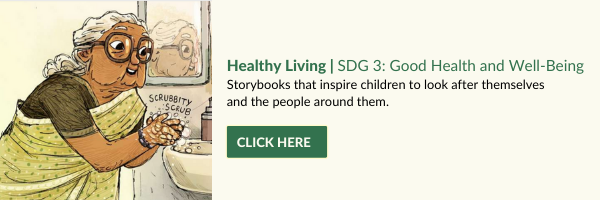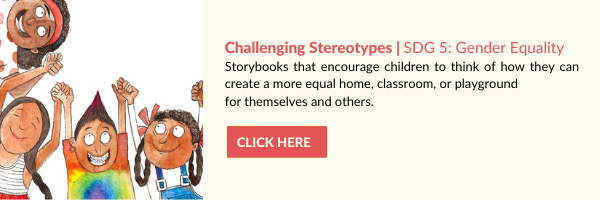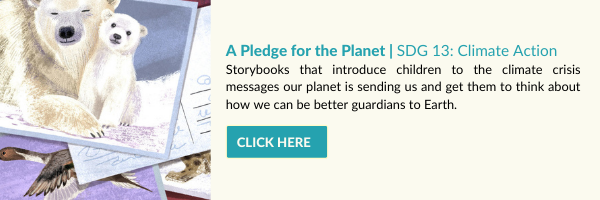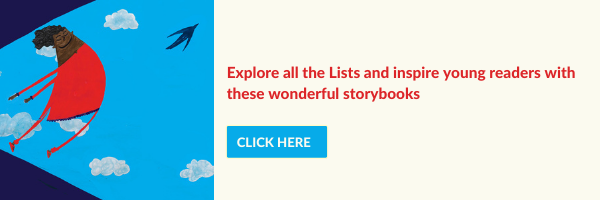Celebrating 10 million reads on StoryWeaver!
Posted by Pallavi Kamath on February 21, 2021Post by Purvi Shah, Director - StoryWeaver
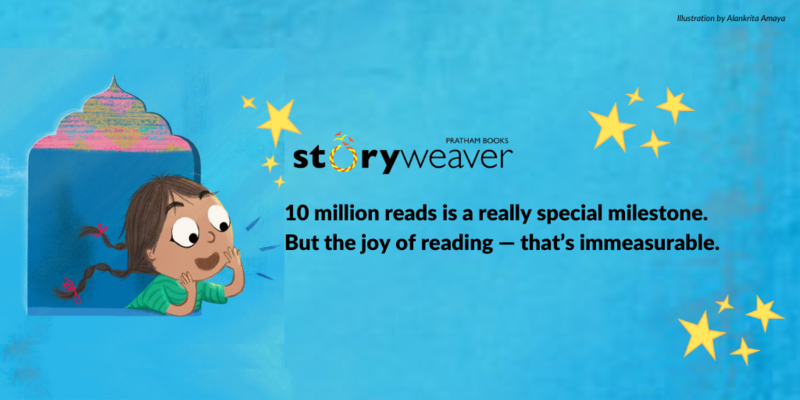

We must admit, we’ve been watching the number next to Reads with bated breath for the past few days.
One crore. Ten million.
However you interpret the numerals, it’s tens of thousands of reads, and it puts a massive smile on our faces to think of children across the world enjoying reading books on StoryWeaver.
It’s also a very, very special milestone to cross.
Special, for children like Manisha who speak Gondi (an Indian tribal language), but until recently had no access to books in their mother tongue, and who read their very first storybook in Gondi, which was created on, downloaded and printed from StoryWeaver.
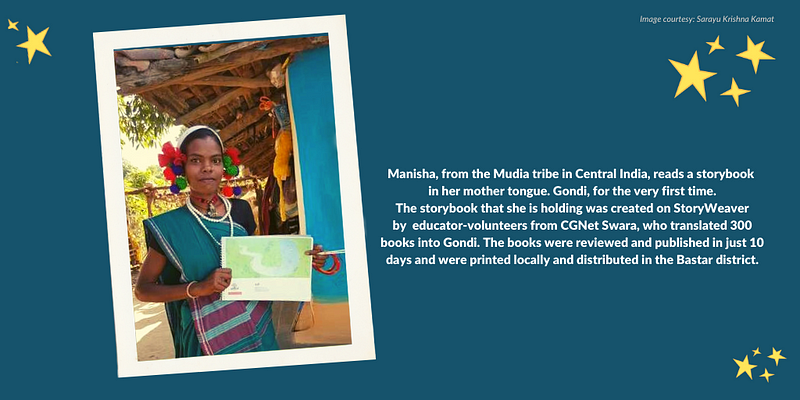
Special, for teachers like Gangadhar, who keep their students spellbound and build their reading and pronunciation skills with Readalongs.

Special, for partners like Room to Read and Asia Foundation who help underserved children read.

Special, for community libraries like The Community Library Project in Delhi, who help dozens of children read and enjoy these books, even during difficult times during the pandemic, when they were unable to visit the physical library.
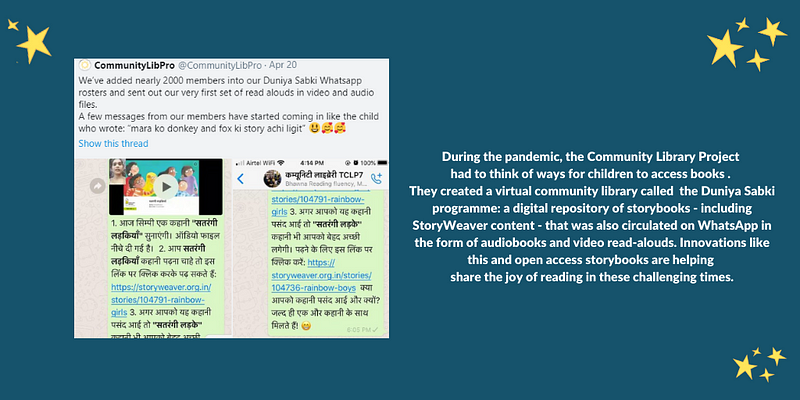
Special, for young readers like Vaishnavi, who haven’t been to school for months due to the pandemic, but are continuing their reading journey using books from StoryWeaver.

And special for us, because it captures everything we stand for: Joy, Inclusion, Empowerment and Integrity.
It’s been five thrilling years of creativity, innovation, and collaboration. And the best part? 10 million is already in the rearview mirror, as we fly on towards the next milestone.
Thank you for reading this far, and if you like our work, do consider partnering with us, and supporting us— there are millions of children still to discover the joy of reading.
Help us continue to give children free access to books. Click here to support StoryWeaver.
If you are part of an organization that promotes reading and learning among children, and you would like to partner with us, write to us at [email protected].
comments (2)We turn 5 today and we're renewing our commitment to quality education for all children with these very special Book Lists 📚⭐
Posted by Pallavi Kamath on September 08, 2020Today is a significant day: It is International Literacy Day, and 5 years since the launch of StoryWeaver. The pandemic has only deepened our resolve to help achieve United Nations’ Sustainable Development Goal 4: Quality Education, by giving children around the world access to high-quality multilingual reading materials, and strengthening the publishing ecosystem to enable this.
September is also the 5th anniversary of the Sustainable Development Goals (SDGs). We are delighted to mark this shared milestone with a specially curated set of Book Lists, featuring storybooks that highlight concepts, values and principles related to the SDGs.
We hope that these Lists will be a useful resource for educators and look forward to them sparking meaningful conversations about subjects like equality, peace and climate action – and inspiring the next generation of readers and learners.
Thank you to all the wonderful people who make the StoryWeaver community such a rich and vibrant one: our young readers, committed educators, brilliant creators, talented translators, farsighted publisher partners, and encouraging donors. StoryWeaver now offers more than 24,000 open source storybooks in over 260 languages.
With your support we can make Literacy and Quality Education a reality for all children.
Illustrations credits:
Shrujana Shridhar for बेटियाँ भी चाहें आज़ादी written by Kamla Bhasin, published by Pratham Books | Priya Kuriyan for सतरंगी लड़कियाँ written by Kamla Bhasin, published by Pratham Books | Archana Sreenivasan for P.S. What's up with the
हर नया अनुवाद भाषा के क्षितिज को कुछ आगे सरकाता है
Posted by Remya Padmadas on October 04, 2019Madhu B. Joshi prefers to be known as a communication practitioner. She sees a great need for demystification in daily life and has been trying to work towards it. She has taught translation and a short, self-designed course of Indian culture, mentored content teams of major education NGOs and designed educational audio-video programmes for CIET and NCERT. Joshi is a translator of Hindi poetry and short fiction in English and has presented major black feminist writers in Hindi. She is also a prolific and visionary collaborator of StoryWeaver, and has translated many storybooks into Hindi including मुझे खोज कर दिखाओ! and बाग की सैर. You can read all her stories on StoryWeaver here.
Apart from all of the above, we also know and love the other मधु बी. जोशी (in her own words)... जो खाना पकाना, इलाज करना, पौधे और कुत्ते पालना, राय देना.. जैसे बहुत से मुफ़्त काम करती हैं। उन्हें सब से ज़्यादा मज़ा बच्चों के लिए काम करने में आता है और वह इसका कोई मौका नहीं चूकतीं।
In this blog post, Joshi writes about the complexity of translation and the many challenges it presents.
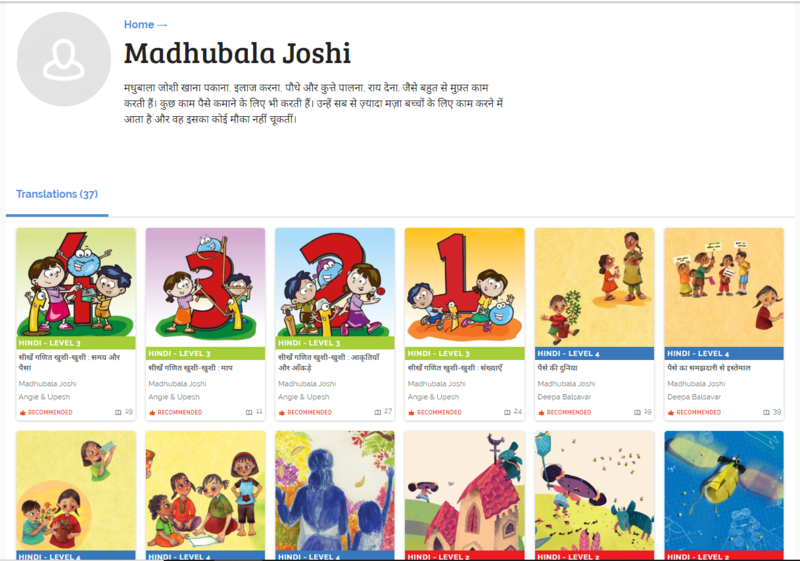
Stories translated into Hindi by Madhu B. Joshi on StoryWeaver.
स्टोरीवीवर की कहानियों का अनुवाद हमेशा चुनौती साथ लाता हैः हमें ठीक-ठीक मालूम नहीं होता कि कहानी का पाठक दुनिया के किस हिस्से में है, उसकी आयु या शैक्षणिक पृष्ठभूमि क्या है, वह प्रस्तुत पाठ को किस उद्देश्य से पढ़ रही है, क्या हमारे शब्द उसके लिए भी वही अर्थ रखते हैं, क्या हमारा किया अर्थान्वय उसके लिए भी कारगर रहेगा?.....अनेक प्रश्न बार-बार कलम रोकते हैं। और फिर लेखक के मूल कथ्य और मंतव्य को पकड़ने की चुनौती तो हमेशा ही अनुवादकों के सामने रहती है-अरे मन संम्हल-सम्हल पग धरिये!
एक मोटा-मोटा सूत्र राह दिखाता हैः अनूदित सामग्री पढ़नेवाले पाठक के लिए वही मूल रचना है। लेकिन नामों और रिश्तों का जटिल संसार कभी-कभी बहुत कड़ी परीक्षा लेता है। एक कहानी में दक्षिण भारतीय मुख्य चरित्र, जो एक लड़का था, का नाम सत्या था, हिंदी मे यह लड़कियों का नाम होता है; तो नामों के मूल रूप बनाए रखने की ताकीद के बावजूद मैंने उसका नाम सत्य कर दिया क्योंकि मुझे हिंदी के पाठकों को भ्रम में न डालना ज़्यादा महत्वपूर्ण लगा। हाल ही में गोआनी मूल के ईसाई लेखक की लिखी सुंदर और बहुत रोचक कविता-कहानी में शवयात्रा के समय बजनेवाले बैंड (भारत में कम ही जगह इस तरह का चलन है) का उल्लेख आया। इसे हिंदी के बाल-पाठक को समझाने के लिए हमें लंबी-चैड़ी टिप्पणी देनी पड़ती जो पढ़ने का मज़ा ही किरकिरा कर देती। तो हल निकाला शवयात्रा का उल्लेख गोल करके; पाठ की रोचकता बरकार रही, उस की गुणवत्ता हल्की नहीं हुई।
लेकिन कई बार तकनीकी शब्दावली की यांत्रिकता आड़े आती हैः प्रचलित शब्द गोल/गोला से पता नहीं चलता कि वह किसी पिंड का संकेत दे रहा है या द्विआयामी आकृति काः गेंद भी गोल है, और नंगी आंख से धरती से दिखता चांद भी! अब अगर हम सायकिल के पिंडाकार पहियों की बात कहना चाहें तो कैसे कहेंगे? एक और बड़ी समस्या पशु-पक्षियों-कीट-पतंगों-वनस्पतियों के नाम हिंदी में बताते हुए आती है। इस संदर्भ में ‘ताल का जादू’ के हिंदी अनुवाद की याद आती है। इसमें उल्लिखित कई पक्षियों और कीटों के नाम मुझे नहीं पता थे। हमारी प्रचलित शब्दावली में, कई कारणों से इन में से बहुत के नाम उपलब्ध नहीं हैं; किसी वैज्ञानिक शब्दावली में मिल भी जाएं तो शेर-बाघ-तेंदुए के बीच अंतर न जानने वाले हमारे पाठकों के लिए वे इतने अपरिचित होते हैं कि अंग्रेज़ी नाम देना भी ठीक ही लगता है-जैगुआर कहने पर यह संभावना बनी रहेगी कि कोई जानकार उसे इसका अर्थ समझा सकता है (वैसे जैगुआर अमेरिका में पाए जाने वाले तेंदुए हैं)। बेसिल का अर्थ आमतौर पर तुलसी लगाया जाता है लेकिन तुलसियां भी कम से कम छः तरह की होती हैं, बेसिल में यह तथ्य निहित है, तुलसी में नहीं।
हर नया पाठ अनुवादक के लिए नई चुनौती लाता है। हर नया अनुवाद भाषा के क्षितिज को कुछ आगे सरकाता है।
We'd love you to join the conversation by letting us know your thoughts in the comments section below.
For more updates, follow us on social media: Facebook, Twitter,Instagram.
Be the first to comment.